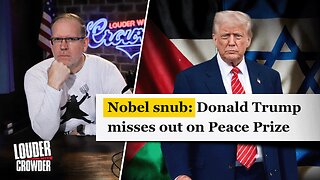Premium Only Content

Episode 3145: Traditionis Custodes vs. Quo Primum: Contradiction or Continuity?
Nightly Zoom Coordinates for Rosary:
Meeting ID: 865 8978 0399
Passcode: Wjjv4960!
Speak Lord for your Servant is Listening
Book Recommendation of the Day
"St. Bonaventure: The Seraphic Doctor" by Fr. Laurence Costelloe
• A good introduction to his life, theology, and importance in the Church.
“Traditionis Custodes vs. Quo Primum: Contradiction or Continuity?”
This episode examining the juridical, theological, and pastoral conflict between Pope St. Pius V’s 1570 Apostolic Constitution Quo Primum and Pope Francis’ 2021 motu proprio Traditionis Custodes.
INTRODUCTION
Welcome to CR, where the unchanging truths of the Catholic Faith shine through the fog of modern confusion.
In today’s episode, we address a deep and painful wound in the Church: the contradiction between two papal documents separated by 451 years one that codified the Traditional Latin Mass for all time, and one that seeks to suppress it.
Pope St. Pius V, in his 1570 bull Quo Primum, declared that the Roman Rite was to be preserved “in perpetuity”, and that no priest should ever be compelled to use another rite.
Pope Francis, in his 2021 document Traditionis Custodes, claimed that the Novus Ordo is now the “unique expression” of the Roman Rite and that bishops should restrict and eventually phase out the traditional liturgy.
Can these two positions be reconciled?
Has the Church contradicted herself?
What is the faithful Catholic to do?
Let us begin in prayer.
PART I: TWO DOCUMENTS, TWO VISIONS
Let us lay out the purpose, structure, and spirit of both Quo Primum and Traditionis Custodes.
A. Quo Primum Tempore (Pius V, 1570)
• Issued after the Council of Trent to end liturgical confusion and prevent Protestant innovations
• Codified the Missale Romanum (Roman Missal) that developed organically over 1,500 years
• Preserved doctrinal clarity, sacrificial theology, and unity of worship
Key provisions:
• The Traditional Mass is to be used “in perpetuity”
• Any additions, omissions, or changes to the missal are forbidden
• Every priest of the Latin Rite has the right to use it without permission
• Anyone who contravenes the decree “incurs the wrath of Almighty God and of the Apostles Peter and Paul”
It enshrines a liturgy formed by tradition, not innovation.
B. Traditionis Custodes (Francis, 2021)
• Framed as a response to “divisive” use of the Traditional Latin Mass
• Revokes Summorum Pontificum (2007), which had liberalized the TLM
• Declares that the Novus Ordo is the “unique expression of the lex orandi”
• Restricts celebration of the TLM to limited, bishop-approved contexts
• Prohibits TLM in parish churches and the establishment of new TLM groups
Pope Francis claims the TLM causes division, contradicts Vatican II, and hinders unity.
PART II: A JURIDICAL CONTRADICTION
A. Quo Primum grants an irrevocable perpetual right
“This present Constitution cannot be revoked or modified, but remains always valid in perpetuity.”
This is a legal term in canon law called a perpetual indult. According to traditional canonical interpretation (e.g., Blot, Wernz-Vidal):
• A future pope cannot nullify a perpetual privilege granted by a prior pope unless:
o He acts with equal or greater authority
o He provides grave and just cause
o He maintains doctrinal continuity
No such justification or equal authority is found in Traditionis Custodes.
B. Traditionis Custodes suppresses rights without a juridical foundation
Francis:
• Asserts the Novus Ordo as the only legitimate form
• Does not reference Quo Primum, Trent, or the theology of the rite
• Provides no theological or canonical rationale for overriding immemorial custom
In canon law, custom exceeding 100 years (let alone 1,500) has the force of law (cf. Canon 26, 1983 Code).
Canon 26 of the 1983 Code of Canon Law states:
"Unless it is otherwise established, a custom is not revoked by a contrary law if the law does not expressly mention the custom; however, if the custom is centenary or immemorial, it is only revoked if the law expressly mentions it."
(Latin: "Nisi aliud expresse caveatur, consuetudo non revocatur per legem contrariam, si lex non contineat mentionem de consuetudine; si autem consuetudo sit centenaria vel immemorabilis, non revocatur nisi id expresse dicatur.")
Explanation (Traditional Catholic Perspective):
Canon 26 addresses the power and endurance of ecclesiastical custom in relation to newly established laws.
• Custom vs. Law: In canon law, custom is a repeated practice that becomes law over time through the consent of the faithful and the tacit approval of Church authority.
• Ordinary Custom (less than 100 years): A new law must explicitly mention that it revokes the custom, otherwise the custom remains valid.
• Centenary or Immemorial Custom (100+ years or so old that its origin is unknown): Such a custom holds great weight and cannot be revoked by a new law unless the new law explicitly states that it does revoke it.
Application:
Traditional Catholics often reference Canon 26 to defend longstanding liturgical customs, such as the Traditional Latin Mass, especially in light of more recent Church directives that seem to restrict or replace them.
• For example, defenders of the Tridentine Mass argue that since it has been celebrated for centuries (immemorial usage), no new law (such as the Novus Ordo Missae or restrictions on the TLM) can override its legitimacy unless it explicitly revokes the custom and even then, only under very particular conditions, considering divine and ecclesial law.
Thus, Traditionis Custodes contradicts:
• Quo Primum
• Canon Law
• Ecclesial tradition
C. Benedict XVI’s Summorum Pontificum (2007) affirms Quo Primum
“The Roman Missal promulgated by St. Pius V… was never juridically abrogated and remains, in principle, always permitted.”
Benedict calls the Novus Ordo a reform, not a replacement, and emphasizes continuity.
Francis reverses this by:
• Declaring the reformed Missal as the sole expression
• Treating the traditional Mass as an exception or abuse
•
PART III: THEOLOGICAL CONTRADICTION
A. The TLM vs. Novus Ordo: A Doctrinal Shift
The Mass is not just a form. It’s a doctrinal act.
The TLM:
• Emphasizes the propitiatory sacrifice of Calvary
• Maintains strict separation of priest and laity
• Offers vertical, God-centered worship
• Communicates the Real Presence through every gesture
The Novus Ordo:
• Minimizes sacrificial language in favor of “memorial”
• Favors dialogue and horizontal participation
• Replaces offertory prayers with ambiguous Jewish-style blessings
• Permits abuses and irreverence through lax rubrics and flexibility
B. “Lex Orandi, Lex Credendi”
“The law of prayer is the law of belief.”
If you change the liturgy, you change belief. And what have we seen since the Novus Ordo?
• 70% of Catholics no longer believe in the Real Presence
• Mass attendance has dropped by over 80% in many dioceses
• Vocations and confessions have plummeted
• A “community meal” theology has replaced “sacrifice”
This is not development it’s rupture.
PART IV: THE FRUITS OF EACH DOCUMENT
A. Quo Primum (1570–1960s):
• Doctrinal consistency
• Martyrs and saints nourished by the Mass (e.g., Thomas More, John Vianney, Pius X, Padre Pio)
• Sacred architecture, music, vestments, and religious life flourished
• The Mass was understood as a holy action not a communal event
B. Traditionis Custodes (2021–present):
• Traditional parishes suppressed or marginalized
• Faithful scandalized, disheartened, driven underground
• Seminarians divided and silenced
• A generation returning to tradition now treated as disobedient
“By their fruits you shall know them.” – Matthew 7:16
The Traditional Mass builds. The imposed reforms scatter.
PART V: CAN THE CHURCH CONTRADICT HERSELF?
The answer is: No in matters of faith and morals, the Church cannot teach error.
But:
• Pastoral governance can err
• Liturgical discipline can be misused
• A Pope can fail to uphold tradition, as in the case of Pope Honorius I, who was condemned for failing to suppress heresy
The TLM represents organic tradition.
The Novus Ordo is a constructed invention (as admitted by its authors, including Bugnini and Fr. Gelineau).
Thus, to elevate the Novus Ordo as the “only expression of the Roman Rite” is to redefine what the Roman Rite even is.
PART VI: WHAT FAITHFUL CATHOLICS MUST DO
1. Know Your Rights
Quo Primum and Summorum Pontificum affirm:
• The right of priests to say the TLM
• The right of the faithful to attend it
• The impossibility of total suppression
2. Respond with Clarity and Charity
• Speak firmly, but respectfully
• Educate others on the historic, theological, and legal basis for the TLM
• Expose errors without falling into schism or bitterness
3. Build and Defend Traditional Communities
• Support traditional orders
• Help build schools, chapels, and seminaries grounded in the Mass of the Ages
• Establish lay organizations and apostolates devoted to restoration
4. Pray, Sacrifice, Persevere
• Offer Rosaries for bishops and priests
• Fast on Fridays for liturgical restoration
• Remain rooted in the Mass, no matter the trial
St. Athanasius stood alone against the Arian bishops. So too may we need to stand for the Mass.
“They have the buildings, but we have the Faith.”
CONCLUSION: CONTRADICTION CANNOT BE CATHOLIC
Quo Primum and Traditionis Custodes are irreconcilable. One preserves. One suppresses.
But the Mass of the Ages cannot be extinguished. It was formed by the Holy Ghost, handed down through the saints, and protected by the Blood of the Lamb.
Let no one take from you what Christ gave to His Church.
“We are not innovators, but the faithful guardians of what we have received.” – St. John Henry Newman
Epistle – 2 Timothy 4:1–8
“I charge thee, before God and Jesus Christ, who shall judge the living and the dead, by His coming and His kingdom: preach the word: be instant in season, out of season: reprove, entreat, rebuke in all patience and doctrine…”
Reflection on the Epistle:
St. Paul’s exhortation to his spiritual son Timothy is strikingly relevant today. The Apostle urges constancy in preaching the truth even when it is inconvenient or unpopular. "In season and out of season" captures the essence of Catholic witness in our modern age where the Gospel is often rejected or distorted.
This epistle reminds us that preaching the faith is not just for clergy it is the vocation of all the baptized. Whether we are fathers, mothers, workers, or students, we must be faithful to the truth with patience and doctrine. Not our opinions, not diluted slogans, but the fullness of the Faith.
The crown of justice awaits not those who compromised, but those who, like St. Paul, “fought the good fight” and “kept the faith.” May we, too, be numbered among them by persevering in truth even when the world turns against us.
Gospel – Matthew 5:13–19
“You are the salt of the earth. But if the salt lose its savour, wherewith shall it be salted? …You are the light of the world… So let your light shine before men, that they may see your good works and glorify your Father who is in heaven.”
Reflection on the Gospel:
Our Lord does not call His disciples to be hidden or lukewarm. He calls them to be salt and light elements that transform everything they touch. Salt preserves, seasons, and purifies. Light dispels darkness and reveals what is true.
But Christ also warns us: if the salt loses its savor, it is worthless. In the same way, a Catholic who hides his faith, or waters down doctrine, ceases to preserve the truth and becomes indistinguishable from the world.
This Gospel is a call to bold holiness not activism or pride but to sanctity that illumines by example. Let us not fear to be openly Catholic, to keep the commandments, and to teach them without apology, as our Lord says: “He who shall break one of these least commandments and shall so teach men shall be called least in the Kingdom of Heaven.”
Saint of the Day – St. Bonaventure, Bishop and Doctor
Today we honor St. Bonaventure, known as the “Seraphic Doctor.” Born in 1221, he was a Franciscan and eventually became Cardinal Bishop of Albano. His theological brilliance was only matched by his profound humility and holiness.
St. Bonaventure defended the Catholic faith amidst the theological chaos of his time, harmonizing scholastic rigor with the mystical love of God. He once said, “If you learn everything except Christ, you learn nothing. If you learn nothing but Christ, you learn everything.”
Like the salt and light described in today’s Gospel, Bonaventure illuminated the Church with clarity, sanctity, and truth.
Quotes & Themes for Meditation:
• “Preach the word… in season, out of season.” (2 Tim 4:2)
→ Stay steadfast in truth, especially when it’s unpopular.
• “You are the salt of the earth… the light of the world.” (Matt 5:13–14)
→ Catholics are meant to be visible signs of holiness, not hidden ones.
• St. Bonaventure: “Christ is both the way and the door. Christ is the staircase and the vehicle... the pattern and the price.”
Themes:
1. Bold, unwavering proclamation of Catholic truth is not optional.
2. The faithful must maintain flavor and clarity—true Catholic identity.
3. Saints like Bonaventure model both intellectual fidelity and profound humility.
Conclusionary Prayer:
Let us now close in prayer:
O God, who gavest blessed Bonaventure to Thy people as a model of virtue and a doctor of holy wisdom, grant that by his intercession, we may ever thirst after true holiness and shine with the light of Christ in all we say and do.
Grant us, O Lord, the courage to be salt and light in a world that is bland and dark with error. May we, like St. Paul and St. Bonaventure, proclaim Thy truth with patience and perseverance. And may our lives always reflect Thy glory.
Through Christ our Lord. Amen.
St. Bonaventure, pray for us.
Sacred Heart of Jesus, have mercy on us.
Our Lady, Seat of Wisdom, pray for us.
In the name of the Father, and of the Son, and of the Holy Ghost. Amen.
Thank you for joining us today. Until next time, keep the Faith, fight the good fight, and never forget that the Church has not changed she has only been eclipsed. Christ is the same yesterday, today, and forever.
-
 1:05:42
1:05:42
Dear America
3 hours agoShould Christians Celebrate Halloween?
13.3K5 -
 2:03:24
2:03:24
The Culture War with Tim Pool
5 hours agoAntifa Is A Terror Organization, Crackdown Coming As Leftists Defend Violence | The Culture War
150K151 -
 28:39
28:39
Afshin Rattansi's Going Underground
5 days agoThe Trump Plan to Save US Economic Hegemony You Haven’t Heard Of (Jim Rickards)
19K2 -
 1:47:43
1:47:43
Lara Logan
17 hours agoROSEANNE UNLEASHED: Bolder Than Ever, Plus an Exclusive Peak at Her New Show | Roseanne Barr | Ep 39
17.7K6 -
 1:14:27
1:14:27
Steven Crowder
6 hours agoTrump Gets Screwed out of Nobel Prize - And They're Actually Thrilled About It
221K318 -
 46:24
46:24
The Rubin Report
4 hours agoListen to Dem Stutter as He’s Forced to Admit Trump Did the Impossible
49.4K23 -
 17:13
17:13
Neil McCoy-Ward
2 hours ago🚨 NATO Just Announced WHAT?!
9.88K19 -
 2:39:37
2:39:37
The Shannon Joy Show
4 hours agoCountdown To SJ Live - Hey Fam Town Hall 12pm ET LIVE! Tune In HERE
15.1K3 -
 1:36:51
1:36:51
The Mel K Show
4 hours agoMORNINGS WITH MEL K -Grand Conspiracy Against the People of the United States Unfolds 10-10-25
21.7K10 -
 1:02:15
1:02:15
Dr. Eric Berg
4 days agoThe Dr. Berg Show LIVE October 10, 2025
31.4K11